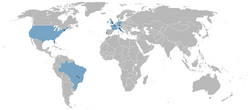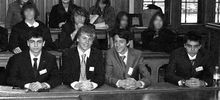Federal Republic of St.Charlie
Federal Republic of St.Charlie | |||||||||
|---|---|---|---|---|---|---|---|---|---|
| 2008-2017 | |||||||||
| Motto: Risorti dalla rivoluzione | |||||||||
| Anthem: Auferstanden Aus Ruinen - Instrumental | |||||||||
 St.Charlian claims in black upon its dissolution in 2017 | |||||||||
| Capital | City of Tor Pendente, Tor Pendente | ||||||||
| Largest city | Branson, District (upon dissolution) | ||||||||
| Official languages | Italian, English | ||||||||
| Demonym(s) | St.Charlian | ||||||||
| Government | Federal parliamentary republic | ||||||||
• President | Alexander Reinhardt (last) | ||||||||
• Prime Minister | Alexander Eastwood (last) | ||||||||
| Legislature | Parliament | ||||||||
| Establishment | 23 November 2008 | ||||||||
| Area | |||||||||
• Total | 152.025 km2 (58.697 sq mi) | ||||||||
| Population | |||||||||
• Census | 150 (at height) | ||||||||
| Currency | Pianeta | ||||||||
| Time zone | (UTC±0 to +1) | ||||||||
Website Official website | |||||||||
| |||||||||
This nation was a member of MCA, UMI and EMCO. | |||||||||
St.Charlie, officially the Federal Republic of St.Charlie or Saint Charlie (Italian: Repubblica Federale di San Charlie), was a territorial transcontinental micronation with territories in Europe, South America and North America. St.Charlie was a member state of the League of Secessionist States, Grand Unified Micronational and a member of the Organisation of Active Micronations pre-dissolution. Originally established as a parliamentary presidential federal republic with a single-party system in 2008 as the successor to the Kingdom of St.Charlie, multiple parties became allowed through the Branson Act 2009.
St.Charlie was one of the largest micronations in the MicroWiki by area, and one of the few territorial ones. The micronation was seen as a major power within months after its foundation, having strong economic, cultural, and political influence. During 2008 and the first semester of 2009, St.Charlie became a symbol of unity and micronationalism in a high school in London.
St.Charlie was a micronationally-developed country and possesses a stable notaphiliac economy. St.Charlie was one of the founding members of the Grand Unified Micronational and a full member prior to its 2010-11 inactivity. The organisation of its national legislature makes St.Charlie one of the most democratic micronations in the community. It is also a member of the Micronational Co-operation Alliance and the European Micronational Culture Organisation. In July 2010, St.Charlie was awarded the Organisation of Active Micronations Award for Economic Development and has been placed first in OAM Influence Survey in October 2010 and January 2011, second place in March 2011.
In later years, St.Charlie's internet presence has been inactive.[1] St.Charlie later dissolved in 2017.
Etymology
The name "St.Charlie" comes from the union of the word "Saint" and the name "Charlie" and was adopted as the official name of the Republic since its creation as a Kingdom, in late 2000. There are various theories as to the origin of the name "St.Charlie". One is that it is derived from the name of Cardinal (and Saint) Charles Borromeo, later informally adapted with the name "Charlie".
Another proposed origin is that in the late 80s, the Ruvolo family owned a black poodle, indeed called "Charlie", and who later gave name to the micronation, though the option was excluded by both new and old St.Charlians.
However, it is also possible that the word is derived from the etymology of the name "Charles" or "Charlie", which is derived from the Germanic name Karl, meaning "free man" and therefore in this case, "free from Italian borders".
History
From Monarchy to Republic
The monarchy ruled St.Charlie from late 2000 until November 2008. It was in that month, however, that the ruling monarch Patrizio I decides to abdicate due to health problems. On the 15th, the Monarchy officially dissolved and the November Revolution mainly supported by the Movement for St.Charlian Liberation started. A counterrevolutionary guerrilla army formed by supporters of the Monarchy was crushed in the first days, while the Movement started gaining support. On the 20th of November, Alexander Reinhardt and Whisky I seized control of the Royal Palace (today the Presidential Palace), establishing the National Party of St.Charlie and officially dissolving the Kingdom. In the three following days, the constitution was drafted and the scheme of the new St.Charlie was formed, including the new currency, the Pianeta. The Constitution was promulgated on the 23rd and the Federal Republic was established.
Branson Act 2009

Right after the Revolution, St.Charlie was a single-party republic. The Parliament, in December 2008, was mainly formed by standing members of the National Party and Whisky I was nominated General Secretary of the NPSC on December 1. Culture was also very different from the modern Republic, with proper dressing codes required for the political class. As an example, Parilament members' "uniform" was formed by a dark frock coat, wing-collared shirt and neck tie (today the dress remains part of the culture of District).
As a single-party republic, St.Charlie started getting more involved in the intermicronational community, with its entrance in the Countries United in National Trade and the Grand Unified Micronational. It is however during mid-January 2009 that St.Charlie gets the political shape it still has now: on the 21st, the Branson Act is approved and signed by the members of the 1st Reinhardt Administration. Several aspects of the political system of the Federal Republic change drastically, such as the liberty of founding other political parties. As a result of the Act, two days later, on the 23rd the St.Charlian Socialist Movement is founded by Fabiana Gallo della Loggia, who will lead it until January 2010.
The school project and the Golden Era
As St.Charlie became more involved in the intermicronational community, its territory was subject of major changes too. Before the Branson Act, the Government decided to claim a region in London, creating the Federation of New Ridgeway. It was the only non-Italian region at the time, and one of its purposes was to let non-Italian citizens get the St.Charlian nationality. Since St.Charlie was also used as a school project by Reinhardt, by February, several people started to apply for citizenship and the Republic became popular inside the school. It was the start of the Golden Era of New Ridgeway.

The Golden Era was a period in St.Charlie that lasted approximately from February to June 2009. It was characterized by a strong demographic and geographical growth, with the formation of the federation of Cascia del Pinzanello in May, and a great popularity of St.Charlie within an English school in where Alexander Reinhardt was studying for his International Baccalaureate. The economy was also advantaged by this sudden popularity, with citizens and non-St.Charlians buying banknotes, passports and all sorts of memorabilia. The high support of the people in the Reinhardt-led Government, the formation of various institutions such as the Ministry of War Information, the Order of the Blue Star or the St.Charlie Broadcasting Network, and the signing of the Aberystwyth Agreement lead to an unusual case of micronational patriotic unity within New Ridgeway (that further increased after the creation of the F.C. St.Charlie), and a relative degree of political, social, and economic stability.
The "Big Five"
Excluding the President of the St.Charlian Parliament, five ministers were recognized for their contribution to the "young" St.Charlie, and were known as the "big five" in New Ridgeway. Three of them were also awarded the Order of the Blue Star.
The big five were:
- Alexander Reinhardt, Prime Minister
- Heinrich Schneider, Secretary of the Treasury, was able to eliminate the national debt
- Daven Savoie, Minister of Justice, established the "basic" judicial system
- Nicolas Bermejo, Minister of Defense
- Mohamad Osman, Minister of Home Affairs
Post-personal project
As a result of the end of the school year and the termination of the school project, St.Charlie's popularity in New Ridgeway started to slowly decline, and only a few interested followers became active citizens. This can be seen with the turnout in New Ridgeway in the last General Elections. From July to August, St.Charlie suffered of a short period of inactivity internally and focused on intermicronational affairs. In July, Reinhardt is elected, under Chairman James Stewart, Vice Chair of the Grand Unified Micronational. During the post-personal project period, St.Charlie decided to take part in numerous campaigns, such as the ones against Oud-Saeftinghe and Rhodesia.
Political changes and the IInd Legislature
As a result of the sudden fall of activity within the internal sector, the Parliament was dissolved in September 2009 and Legislative Elections were held in the second part of October.
The newly founded federations of Caroline Charlotte and Tor Pendente, together with the federations of District and New Ridgeway, were allowed for the first time to elect their Presidents, who would have represented them at the General Assembly of the St.Charlian Parliament.
On November 1, 2009, the following politicians were nominated MPs of the IInd Legislature:
- Tor Pendente: Valentina Marchesi, NPSC
- District: Barbara Ruvolo, NPSC
- Caroline Charlotte: Heinrich Ritter, SCSM
- New Ridgeway: Elena Ferranti, SCSM
Together with the Secretaries and Vice Secretaries of the NPSC and the SCSM, they formed the new St.Charlian Parliament, which was subject to a major change.
General Elections of 2010 and Second Reinhardt Administration
In December 2009, St.Charlie saw its first general elections in history. Alexander Reinhardt and Fabiana Gallo della Loggia fought against each other after a one month long campaign for the title of Prime Minister.
It was an important election also for the topics discussed: the final development of St.Charlie through the university, the Federal Bank, the future of St.Charlie in diplomatic relations, and the party who would have gained the majority at least in the Government (the Parliament already did not have any majority).
With a turnout of about 60% of the total population, Reinhardt was elected with 65% of the consensus, gaining support of 3 out of 4 voting federations.
Following the result of the elections, Fabiana Gallo della Loggia resigned as leader of the opposition, but joined the Second Reinhardt Cabinet as Minister of Culture and Education, succeeding Mohammed El-Giathi. The new government was officially created on January 6, 2010, exactly one year after the creation of the first government always led by Reinhardt. Of the last cabinet, only Schneider remained Minister, but was assigned the Department of Home Affairs. Through the "De Armis law of simplification", James Lunam, First Ambassador, also became Minister of Foreign Affairs, while Leonard Von Sternberg, commander of the Armed Forces, became Minister of Defense.
New politicians joined St.Charlian politics: Athlon Strauss, diplomat and former Secretary of the Treasury during the post-revolutionary era, was nominated in charge of it again. Nicolò Alvisi, young member of the SCSM involved in the Italian politics, was nominated Minister of Justice. On the same period, SCSM leader Magnus de Armis was elected President of the General Assembly.
Death of Whisky and Post-Whiskyism
President Whisky Archibald Walker I died on March 23, 2010. Following state commemoration and three days of mourning, plans for electing a new president began.
Of the four federations asked to bring up candidates, only the President of Tor Pendente, Valentina Marchesi, proposed two names: Alberto Schönfeld and Lisa Cassidy. After waiting for several days and criticism from Caroline Charlotte, elections were opened on April 13 and concluded at 8pm of the 20th of April, 2010. Lisa Cassidy was elected president with more than 85% of the votes.
The election of Ms. Cassidy as President of St.Charlie marked a new era in the internal politics of St.Charlie. Her nomination indicated that the small federations which were recognized at the time for relatively low achievements were rising against the older federations. Tor Pendente, once an agricultural federation, became the symbol of the "young political class". During the Presidential elections, Alvisi, already Minister of Justice, started working more actively in the politics of the nation and in the Socialist Party. Consequently, on April 20, he was nominated Vice Secretary General of the movement, replacing Fabiana Gallo della Loggia, who on her hand officially stepped down from the party's leadership after more than a year. Furthermore, under President Cassidy, the St.Charlian Commonwealth was founded, on May 26.
Collapse
On 29 July 2015, Koss declared independence from St. Charlie.[2]
In August 2015, Prime Minister Eastwood took control of the government as Chancellor. After this point, the St. Charlian government became almost completely inactive. However, it was not until 21 January 2017 that the Federal Republic officially ceased to exist. Chancellor Eastwood contacted Emperor Jonathan I of Austenasia, informing him that the nation was defunct. Recognition of St. Charlie was at that time revoked by Austenasia. Shortly afterwards, Alexander Reinhardt dismissed calls to declare himself monarch of St. Charlie.[3]
Politics
For more information, visit Politics of St.Charlie
The Federal Republic of St.Charlie was (upon dissolution) led by the New Socialist Party (NSP) after Decision 2013.
The Prime Minister of the Federal Republic was elected by universal suffrage each year, with a campaign which started on December and concluded on January with the elections. His work was to appoint the Cabinet, with the help of the President of the Federal Republic. The President of the Federal Republic was elected by the St.Charlian Parliament every two years.
Although he was the most important person in the Federal Republic, he was usually a representative figure of St.Charlie, while the power was executed by the Prime Minister and its Cabinet.
Government
The Government of the Federal Republic of St.Charlie, was upon dissolution formed with the following members:
-
President of the Federal Republic:
James Lunam -
President of the Parliament:
Valentina Marchesi
-
Minister of Foreign Affairs:
Alexander Reinhardt
(as First Ambassador) -
Secretary of the Treasury:
Athlon Strauss -
Minister of Defense:
Christian Guariberti
(as Chief of Staff of the SCAF) -
Minister of Justice:
Nicolò Alvisi
Foreign relations
Recognized micronations
St.Charlie recognized various micronations in which it signed a treaty of mutual recognition with. There are only a very few micronations that were automatically recognized by St.Charlie, without the use of a formal treaty. They were recognized in the first week of existence of the nation, and no other micronation was added to the list thereafter. However, there are some micronations that were not recognized by St.Charlie for various reasons. At the moment, the only micronations whose territories were not recognized by the Federal Republic are Westarctica, as it claims Siple Island, which is officially known being part of the Grand Duchy of Flandrensis, and the Natlandist People's Directory of Istoria, as it had an embargo and an act of nonrecognition placed on on advice of Riley Small for their homophobic ideals and political extremism.
Nations that were automatically recognized by St.Charlie
Nations that had signed a treaty with St.Charlie
The Federal Republic had also signed various treaties with the following micronations. Most of them were of mutual recognition and non-aggression:
 Free State of Renasia, since 14 December 2008
Free State of Renasia, since 14 December 2008 Grand Duchy of Flandrensis, since 23 May 2009
Grand Duchy of Flandrensis, since 23 May 2009 Cisalpine Republic, since 18 June 2009
Cisalpine Republic, since 18 June 2009 Res Publica SPQR, since the 24 June 2009
Res Publica SPQR, since the 24 June 2009 Reylan Imperial Triumvirate, since 14 July 2009
Reylan Imperial Triumvirate, since 14 July 2009 Empire of Austenasia, since the 10th of December 2009
Empire of Austenasia, since the 10th of December 2009 United Kingdom of New Wessex, since 24 February 2010
United Kingdom of New Wessex, since 24 February 2010 Kingdom of Ruritania, since 24 February 2010
Kingdom of Ruritania, since 24 February 2010 Westarctica, since 14 March 2010
Westarctica, since 14 March 2010 Republic of Lostisland, since the 30 October 2010
Republic of Lostisland, since the 30 October 2010 Federal Republic of Flatland, since the 31 October 2010
Federal Republic of Flatland, since the 31 October 2010 People's Republic of Richland, since 2 November 2010
People's Republic of Richland, since 2 November 2010 Federal Commonwealth of Sirocco, since 15 January 2011
Federal Commonwealth of Sirocco, since 15 January 2011 Kingdom of Überstadt, since 24 January 2011
Kingdom of Überstadt, since 24 January 2011 Kingdom of Broughtopia, since 9 February 2011
Kingdom of Broughtopia, since 9 February 2011 Nemkhav Federation, since 9 February 2011
Nemkhav Federation, since 9 February 2011 Republic of Ultamiya, since 27 March 2011
Republic of Ultamiya, since 27 March 2011 Technocratic Capital of Würdigeland, since 29 November 2012
Technocratic Capital of Würdigeland, since 29 November 2012 Kingdom of Wyvern
Kingdom of Wyvern Kingdom of Juclandia
Kingdom of Juclandia
Inactive nations that had formerly signed a treaty
 Ohio Empire, since 21 December 2008
Ohio Empire, since 21 December 2008 Republic of Petorio, since 21 December 2008
Republic of Petorio, since 21 December 2008 Danburnia, since 22 December 2008
Danburnia, since 22 December 2008 Stigistan, since 27 December 2008
Stigistan, since 27 December 2008 Tozland, since 4 January 2009
Tozland, since 4 January 2009 Roland, since 21 January 2009
Roland, since 21 January 2009 Holy Empire of Reunion, since 5 March 2009
Holy Empire of Reunion, since 5 March 2009 Democratic Duchy of Francisville, since 1 April 2009
Democratic Duchy of Francisville, since 1 April 2009 Socialist Republic of Murrayfield, since 15 April 2009
Socialist Republic of Murrayfield, since 15 April 2009 Kingdom of Finismund, since 13 May 2009
Kingdom of Finismund, since 13 May 2009 Democratic Republic of Vitla, since 25 July 2009
Democratic Republic of Vitla, since 25 July 2009 Free Community of Pasargada, since 31 July 2009
Free Community of Pasargada, since 31 July 2009 Olland, since 24 February 2010
Olland, since 24 February 2010 Promolands Micronation, since 28 April 2010
Promolands Micronation, since 28 April 2010 Aspinburgh, since 6 August 2010
Aspinburgh, since 6 August 2010 Yabloko, since 15 August 2010
Yabloko, since 15 August 2010 Valnor, since 15 February 2011
Valnor, since 15 February 2011
Military
The Federal Republic of St.Charlie had its own armed forces, known as the S.C.A.F (St.Charlie Armed Forces) with four branches of service. Since the Federal Republic was the only micronation in the center of Italy and one of the few in London (together with the Empire of Austenasia), the SCAF was considered to be the most advanced in the whole region, excluding of course Italy and the United Kingdom.
The S.C.A.F was divided into the following three branches, plus a sub-branch of the Army:
- Army (Esercito)
- Military Police (Polizia Militare)
- Navy (Marina St.Charliana)
- Border Troops (Forze di Confine)
The Armed forces had previously included an Air Force, but its activity was suspended due to its uselessness.
The Intelligence agency of St.Charlie was also related to the Ministry of Defense, but not directly related to the S.C.A.F.
The name of the agency was Ministero per le Informazioni Belliche (in English: Ministry for Bellic Information).
National Holidays
| Date | English Name | Italian Name | Remarks |
|---|---|---|---|
| 1 January | New Year's Day | Primo Dell'Anno | |
| 21 January | Branson Day | Giorno di Jonas | Day to commemorate the approval of the Branson Act 2009. Unofficial until February 1, 2010. |
| 15 February | International Dusty Day | Giorno di Dusty | Day against torture on animals |
| 25 February | National Education Day | Giornata Nazionale dell'Educazione | Day that promotes education and culture. |
| 29 April | Armed Forces Day | Festa delle Forze Armate | In honor of the St.Charlie Armed Forces |
| 1 May | May Day | Festa del Lavoro | International Workers' Day |
| 17 May | Day Against Homophobia | Giornata contro l'Omofobia | Day against homophobia. Recognized Internationally. |
| 23 November | Republic and Constitution Day | Anniversario della Repubblica e della Costituzione | National holiday, military parade |
| 11 December | Birthday of Whisky I | Compleanno del Presidente | Military Parade, Presidential Dinner |
| 5 December | Liberty of Expression Day | Giornata per la Libertà di Espressione | Commemorates the No Berlusconi Day and the right of expression. |
| 24 December | First Day of Christmas | Vigilia di Natale | |
| 25 December | Christmas | Giorno di Natale | |
| 26 December | St.Stephan | Santo Stefano | |
| 31 December | New Year's Eve | Capodanno (or San Silvestro) |
Land and Geography
The Federal Republic consisted of a small territory divided in five federations located in Central Italy, West London, Southern Germany, and The Americas.
- District - The central region and former capital city, located in the middle of Upper St.Charlie. It was until the 5th of January, the second-most populous area of the country it by far the largest metropolitan area. The city was also famous for his town square where military parades are located on the National Day.
- Cascia del Pinzanello - The second biggest region of the Federal Republic. Located in the countryside, it was the first and only agricultural source of the Federal Republic until 2012, regularly producing fruits, vegetables, and also wine.
- Caroline Charlotte - The only federation located in Germany. It was a small region with a park. However, the territory claimed is larger than New Ridgeway
- Koss - The biggest region of St.Charlie, and the only transcontinental federation. It claimed territory in three continents(Europe, South America and North America). It was considered as a highly cultural site of the Federal Republic.
- Norwood - Located in the American state of Ohio, it was the second agricultural center in the Federal Republic, producing vegetables, eggs, beer and fruit. Also holds the only Railway in the Federal Republic.
- Greater Ridgeway - The most populous and third-largest Federation of the Federal Republic, it is located in West London it was formed as after the fusion of New Ridgeway and Royal Beresford.
- Tor Pendente - Located next to Bologna, Tor Pendente will soon host the Tor Pendente State University. It is in the countryside.
| Types of Divisions: | Federation • Territory • Permanent Territory |
|---|---|
| Federations: | |
| Territories: | |
| Permanent Territories: | none |
Flora and Fauna

Geographically speaking, Old St.Charlie is located in central Italy, and like its Italian neighbour, has a wide variety of Mediterranean flowers and plants. Old St.Charlie is located 200m above sea level, and as such, it is considered as a zona collinare (in English it is translated with area on the hills). Instead, New Ridgeway (also considered New St.Charlie) is in Central London, and therefore has a temperate marine climate, like all other British Isles. The variety of plants and flowers in New Ridgeway is lower than Old St.Charlie, but still, different kinds of trees and flowers can be seen in the English part of the Federal Republic.
Many small animals can be seen in Lower and Upper St.Charlie, such as the West European Hedgehog (Erinaceus europaeus), the Common Toad (Bufo bufo), but also the Little Owl (Athene noctua), which visits the St.Charlian regions in spring.
However, in New Ridgeway, several tree squirrels like the Grey Squirrel (Sciurus carolinensis) are common visitors of the St.Charlian English gardens.
Media
After the constitution
The Constitution of the Federal Republic of St.Charlie, in Section One, Article 3, clearly states that:
Everyone is free to express and to disseminate his opinion by speech, writing and pictures. Freedom of the press and freedom of reporting by radio and motion pictures are infinite.
— Constitution of the Federal Republic of St.Charlie
Press
The Federal Republic of St.Charlie publishes foreign newspapers, such as the Italian newspapers, but also micronations' newspapers, like The Charwood Tribune or The Danburnian Article. The Federal Republic has a newspaper itself, called The St.Charlian Observer, a periodical newspaper which started typing the 1st January 2009. While on a regional level individual federations have their own newspapers, such as the Kossian Gazette
Television
St.Charlian citizens regularly watch British and Italian television, however, St.Charlie has a State television, called St.Charlie Broadcasting Network or St.Charlie TV. It is used for publishing videos of St.Charlie, the national anthem, and slideshows. It will soon include news and interviews.
National anthem
The anthem chosen by St.Charlie was Auferstanden Aus Ruinen, which was also the former anthem of the German Democratic Republic. The anthem was chosen for various reasons: the main one is probably because St.Charlie was reborn from the ruins of the Kingdom of St.Charlie.







